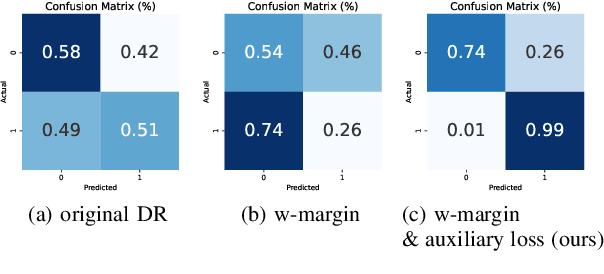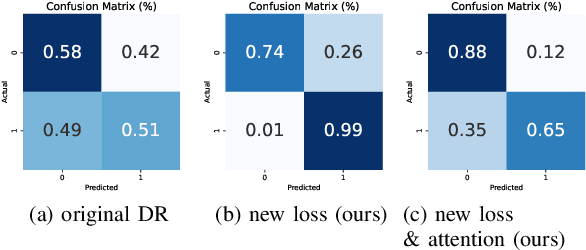Jihyeon Seong
Rethinking Random Masking in Self Distillation on ViT
Jun 12, 2025Abstract:Vision Transformers (ViTs) have demonstrated remarkable performance across a wide range of vision tasks. In particular, self-distillation frameworks such as DINO have contributed significantly to these advances. Within such frameworks, random masking is often utilized to improve training efficiency and introduce regularization. However, recent studies have raised concerns that indiscriminate random masking may inadvertently eliminate critical semantic information, motivating the development of more informed masking strategies. In this study, we explore the role of random masking in the self-distillation setting, focusing on the DINO framework. Specifically, we apply random masking exclusively to the student's global view, while preserving the student's local views and the teacher's global view in their original, unmasked forms. This design leverages DINO's multi-view augmentation scheme to retain clean supervision while inducing robustness through masked inputs. We evaluate our approach using DINO-Tiny on the mini-ImageNet dataset and show that random masking under this asymmetric setup yields more robust and fine-grained attention maps, ultimately enhancing downstream performance.
Towards Dynamic Trend Filtering through Trend Point Detection with Reinforcement Learning
Jun 06, 2024Abstract:Trend filtering simplifies complex time series data by applying smoothness to filter out noise while emphasizing proximity to the original data. However, existing trend filtering methods fail to reflect abrupt changes in the trend due to `approximateness,' resulting in constant smoothness. This approximateness uniformly filters out the tail distribution of time series data, characterized by extreme values, including both abrupt changes and noise. In this paper, we propose Trend Point Detection formulated as a Markov Decision Process (MDP), a novel approach to identifying essential points that should be reflected in the trend, departing from approximations. We term these essential points as Dynamic Trend Points (DTPs) and extract trends by interpolating them. To identify DTPs, we utilize Reinforcement Learning (RL) within a discrete action space and a forecasting sum-of-squares loss function as a reward, referred to as the Dynamic Trend Filtering network (DTF-net). DTF-net integrates flexible noise filtering, preserving critical original subsequences while removing noise as required for other subsequences. We demonstrate that DTF-net excels at capturing abrupt changes compared to other trend filtering algorithms and enhances forecasting performance, as abrupt changes are predicted rather than smoothed out.
* 18 pages, 11 figures
Capsule Neural Networks as Noise Stabilizer for Time Series Data
Mar 20, 2024



Abstract:Capsule Neural Networks utilize capsules, which bind neurons into a single vector and learn position equivariant features, which makes them more robust than original Convolutional Neural Networks. CapsNets employ an affine transformation matrix and dynamic routing with coupling coefficients to learn robustly. In this paper, we investigate the effectiveness of CapsNets in analyzing highly sensitive and noisy time series sensor data. To demonstrate CapsNets robustness, we compare their performance with original CNNs on electrocardiogram data, a medical time series sensor data with complex patterns and noise. Our study provides empirical evidence that CapsNets function as noise stabilizers, as investigated by manual and adversarial attack experiments using the fast gradient sign method and three manual attacks, including offset shifting, gradual drift, and temporal lagging. In summary, CapsNets outperform CNNs in both manual and adversarial attacked data. Our findings suggest that CapsNets can be effectively applied to various sensor systems to improve their resilience to noise attacks. These results have significant implications for designing and implementing robust machine learning models in real world applications. Additionally, this study contributes to the effectiveness of CapsNet models in handling noisy data and highlights their potential for addressing the challenges of noise data in time series analysis.
* 3 pages, 3 figures
CardioCaps: Attention-based Capsule Network for Class-Imbalanced Echocardiogram Classification
Mar 15, 2024



Abstract:Capsule Neural Networks (CapsNets) is a novel architecture that utilizes vector-wise representations formed by multiple neurons. Specifically, the Dynamic Routing CapsNets (DR-CapsNets) employ an affine matrix and dynamic routing mechanism to train capsules and acquire translation-equivariance properties, enhancing its robustness compared to traditional Convolutional Neural Networks (CNNs). Echocardiograms, which capture moving images of the heart, present unique challenges for traditional image classification methods. In this paper, we explore the potential of DR-CapsNets and propose CardioCaps, a novel attention-based DR-CapsNet architecture for class-imbalanced echocardiogram classification. CardioCaps comprises two key components: a weighted margin loss incorporating a regression auxiliary loss and an attention mechanism. First, the weighted margin loss prioritizes positive cases, supplemented by an auxiliary loss function based on the Ejection Fraction (EF) regression task, a crucial measure of cardiac function. This approach enhances the model's resilience in the face of class imbalance. Second, recognizing the quadratic complexity of dynamic routing leading to training inefficiencies, we adopt the attention mechanism as a more computationally efficient alternative. Our results demonstrate that CardioCaps surpasses traditional machine learning baseline methods, including Logistic Regression, Random Forest, and XGBoost with sampling methods and a class weight matrix. Furthermore, CardioCaps outperforms other deep learning baseline methods such as CNNs, ResNets, U-Nets, and ViTs, as well as advanced CapsNets methods such as EM-CapsNets and Efficient-CapsNets. Notably, our model demonstrates robustness to class imbalance, achieving high precision even in datasets with a substantial proportion of negative cases.
* 8 pages, 6 figures
Towards Diverse Perspective Learning with Selection over Multiple Temporal Poolings
Mar 14, 2024



Abstract:In Time Series Classification (TSC), temporal pooling methods that consider sequential information have been proposed. However, we found that each temporal pooling has a distinct mechanism, and can perform better or worse depending on time series data. We term this fixed pooling mechanism a single perspective of temporal poolings. In this paper, we propose a novel temporal pooling method with diverse perspective learning: Selection over Multiple Temporal Poolings (SoM-TP). SoM-TP dynamically selects the optimal temporal pooling among multiple methods for each data by attention. The dynamic pooling selection is motivated by the ensemble concept of Multiple Choice Learning (MCL), which selects the best among multiple outputs. The pooling selection by SoM-TP's attention enables a non-iterative pooling ensemble within a single classifier. Additionally, we define a perspective loss and Diverse Perspective Learning Network (DPLN). The loss works as a regularizer to reflect all the pooling perspectives from DPLN. Our perspective analysis using Layer-wise Relevance Propagation (LRP) reveals the limitation of a single perspective and ultimately demonstrates diverse perspective learning of SoM-TP. We also show that SoM-TP outperforms CNN models based on other temporal poolings and state-of-the-art models in TSC with extensive UCR/UEA repositories.
* 17 pages, 9 figures
 Add to Chrome
Add to Chrome Add to Firefox
Add to Firefox Add to Edge
Add to Edge